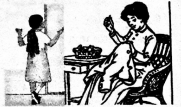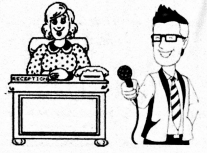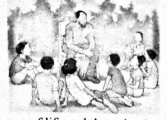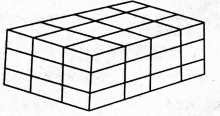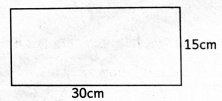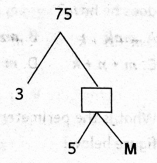Displaying items by tag: grade 5
Shughuli za Kiswahili Questions and Answers - Grade 5 Opener Exams Term 2 2023 Set 2
KUSIKILIZA NA KUZUNGUMZA
Soma mazungumzo yafuatayo kisha ujibu maswali
(Nyanya ameketi chini ya mti akifuma sweta. Anaiweka sweta kando anapomwona Wakesho)
Wakesho : (akimkaribia nyanya) Shikamoo nyanya?
Nyanya : (kwa tabasamu) Marahaba mjukuu wangu! Habari za shule?
Wakesho : Njema nyanya! (kimya) Nyanya, nikwambie kitu?
Nyanya : Naam, niambie mjukuu wangu.
Wakesho : Wenzangu walinichagua kuwa kiranja wa darasa.
Nyanya : Hongera! Jambo zuri sana.
Wakesho : (akijikuna kichwa). Lakini Nyanya, sijui ninastahili kufanya nini ili niwe kiongozi bora.
Nyanya : Aha! Wakesho, sikiliza. Ili kuwa kiongozi bora unastahili kuwa na maadili.
Wakesho : Ooh! Maadili
Nyanya : Naam mjukuu wangu. Unaweza kuonyesha maadili kwa namna mbalimbali. Kwanza usiwe na ubaguzi unapowahudumia wenzako.
Wakesho : Kweli Nyanya, ninafikiria pia ninastahili kuwa na upendo.
Nyanya : Ndiyo Wakesho. Unaweza kufanya hivyo kwa kuwajali na kuwasaidia wenzako wanapokuwa na shida.
Wakesho : Kweli Nyanya! Ninaona kwamba ushirikiano ni jambo muhimu.
Nyanya : Haswa! Kidole kimoja hakivunji chawa. Je, unaweza kushirikiana na wengine kwa njia gani?
Wakesho : (Kwa ujasiri) Kwa kuwahusisha katika mambo mbalimbali.
Nyanya : Vyema! Unastahili pia kuwa na uaminifu. Tunaonyesha uaminifu kwa kusema ukweli na kufanya mambo inavyostahili.
Wakesho: Asante Nyanya! Hakika umenifunza mengi.
- Wakesho alipoulizwa na Nyanya kuhusu habari za shule alimjibu vipi?
- Naam
- Njema
- Shikamoo
- Marahaba
- Ni neno gani ambalo nyanya alitumia kumpongeza Wakesho kwa kuchaguliwa kuwa kiranja?
- Hongera!
- Naam
- Ndiyo
- Haswa!
- Kulingana na kifungu, kiongozi mwema hafai kuwa na ____________________________
- ushirikiano
- heshima
- upendo
- ubaguzi
- Baada ya mazungumzo haya Wakesho anafaa kufanya nini?
- Kufurahia kuwa kiongozi shuleni.
- Kufuata mawaidha ya nyanya
- Kueleza wenzake kuhusu nyanya yake
- Kuwashukuru wenzake
- Maadili ni nini?
- Ushauri
- Kuwajali wengine
- Uongozi mzuri
- Mwenendo mzuri
Swali la 6 hadi la 9
Soma kifungu kifuatacho kisha ujibu maswali.
Simba mwenye njaa, katika pitapita zake za kuwinda, alimkuta Sungura akiwa amelala fofofo. Alishusha pumzi, akatabasamu na kumshukuru sana Mungu kwa ukarimu wake wa kumpatia chakula bila kukifanyia kazi.
Taratibu alimsogelea Sungura ili asije akamwamsha, akalala yeye... Alipoinua miguu yake kutaka kumkamata, mara akatokea swara mnono ambaye alipita akikimbia karibu naye, akielekea upande wa kaskazini kwenye nyasi fupi.
Simba alimwacha Sungura na kumkimbiza yule Swara.Kelele za Simba akimkimbiza swara zilimgutusha na kumwamsha Sungura ambaye aliamka na kutimua mbio kuelekea upande wa kusini.
Baada ya kumkimbiza swara kwa muda mrefu Simba alishindwa na kuamua kurudi ili akamle yule Sungura.
Alipogundua kuwa Sungura naye alikuwa ameamka na kukimbia, Simba alisema kwa kujilaumu, "Ama kweli nimepata nilichostahili; kwa kuwa nilikiacha chakula nilichokitia mkononi tayari kwa tamaa ya kutaka kupata zaidi."
- Ni wanyama wangapi waliotajwa katika kifungu hiki?
- Watatu
- Wawili
- Wanne
- Mmoja
- Kati ya wanyama walio kwenye kifungu ni yupi hali nyasi?
- Swara
- Sungura
- Simba
- Wote
- Hadithi hii inatufunza nini?
- Tuwe na ukarimu
- Tusiwe na tamaa
- Tukifanya makosa tujilaumu
- Tuwe watu wenye shukrani
- Kinyume cha kitenzi tabasamu ni nini?
- Cheka
- Lia
- Nuna
- Waza
Swali la 10 hadi la 12
Soma kifungu kifuatacho kisha ujibu maswali.
Wanafunzi wa gredi ya tano katika Shule ya msingi ya Faulu walipewa mradi wa kutafuta aina mbalimbali za mapambo kwenye mtandao.Wanafunzi waligawanywa katika vikundi vinne kama ifuatavyo: Starehe, Amani, Upendo, Nuru. Kila kikundi kilitafuta mapambo yake. Tazama jedwali hili kisha ujibu maswali
| VIKUNDI | Mapambo | Mapambo | mapambo |
| Starehe | Herini | Pete | Mkufu |
| Amani | Mkufu | Bangili | Herini |
| Upendo | Pete | Mkufu | Bangili |
| Nuru | Bangili | Herini | Pete |
- Ni kikundi kipi hakikupata mapambo ya masikioni?
- Starehe
- Upendo
- Amani
- Nuru
- Ni kikundi kipi hakikupata bangili?
- Nuru
- Amani
- Upendo
- Starehe
- Ni kikundi kipi hakikupata pambo la shingoni?
- Starehe
- Upendo
- Nuru
- Amani
Swali la 13 hadi la 15
Soma kifungu kifuatacho kisha ujibu maswali.
Huduma ya kwanza ni muhimu sana katika maisha yetu. Mtu hupewa huduma ya kwanza anapopata ajali au anapokuwa mgonjwa. Huduma ya kwanza humsaidia mwathiriwa aweze kufika kwa daktari ili kupata matibabu. Mtu akikosa kupewa huduma ya kwanza anaweza akaaga dunia.
Shuleni kuna ajali mbalimbali ambazo hutokea. Ajali hizi ni kama vile: Kuzirai, kuteguka mguu, kuvunjika viungo vya mwili, kuchomeka, muhina (kutokwa na damu puani) kukatwa na kifaa chenye makali na kuumwa na mdudu.
Mtu akizirai kagua kama ameumia kwanza. Kisha mbebe hadi mahali penye hewa safi kama vile kivulini, mlaze chali na uinue miguu yake juu kidogo. Legeza mavazi yaliyombana kwa kufungua mshipi wake, ukosi au mavazi mengine yaliyombana ili apate hewa safi.
Mtu akitokwa na damu puani, mketishe wima huku akiinama upande wa mbele, finya taratibu sehemu iliyo laini ya pua na umwagize apumue kupitia mdomoni kisha uendelee kufinya taratibu kwa muda wa dakika kumi hadi kumi na tano. Mpatie hanchifu ashikilie upande wa pua.
Njia hizi na nyingine ni muhimu kuzijua ili kuweza kuokoa maisha.
- Umuhimu wa huduma ya kwanza ni gani?
- Kumwezesha aliyeumia kufika kwa daktari.
- Kumsaidia mwathiriwa apone.
- Kuleta pesa kwa anayefanya huduma ya kwanza.
- Kumsaidia mwathiriwa kuaga dunia.
- Ni nini maana ya msemo kuaga dunia?
- Kuhamia nchi nyingine
- Kupona
- Kufa
- Kupata nafuu.
- Ni njia ngapi za kufanya huduma ya kwanza zilizoelezewa?
- Moja
- Tatu
- Nne
- Mbili
Soma kifungu kifuatacho. Kina nafasi 16 hadi 20. Umepewa majibu manne hapo. Chagua jibu lifaalo zaidi kati ya yale uliyopewa.
Katika gredi ya tano tumefunzwa mambo __16__. Katika matamshi bora mtu anafaa kusema__17__anapomaanisha kuosha nguo. Vilevile sasa najua kuwa kwaheri ni aina ya __18__. Isitoshe ninaweza kutega na __19__ vitendawili. Zaidi ya hayo ninafahamu kuwa kikosi cha askari ni nomino ya __20__.
| A | B | C | D | |
| 16. | mengi | mingi | vingi | wengi |
| 17. | fua | mvua | vua | vuka |
| 18. | salamu | methali | tashbihi | maangano |
| 19. | kutegua | kujibu | kufumbua | kutegewa |
| 20. | wingi | makundi | kitenzi-jina | dhahania |
Swali la 21-30
SARUFI
Kutoka swali la 21 hadi 30, chagua jibu sahihi.
- Ni picha gani haijaambatanishwa sawasawa na nomino yake ya makundi?
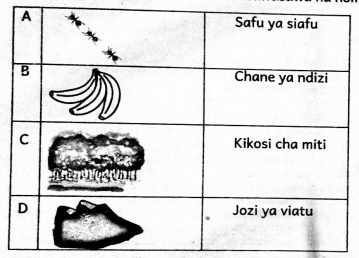
- Watoto wenye nidhamu, huheshimu walimu ____________________A
- wao
- yao
- zao
- vyao
- Anwanipepe hutumika katika uandishi wa
- Barua rasmi
- Barua ya kirafiki
- Baruapepe
- Barua ya kiofisi
- Chagua wingi wa: Nyumba yangu inapendeza
- Nyumba yetu inapendeza.
- Majumba yetu yanapendeza.
- Vijumba vyetu vinapendeza.
- Nyumba zetu zinapendeza
- Zawadi alimsaidia Nuru kuchora picha. Kwa hivyo Zawadi
- alimchoresha Nuru picha.
- alimchorea Nuru picha.
- alichoreshwa picha na Nuru.
- alichoreshea Nuru picha.
- Ni sentensi ipi sahihi?
- Chakula hizi imeiva.
- Mti huu umekatwa.
- Giza hili linatisha.
- Gazeti hii imesomwa.
- Ni sentensi ipi iliyoakifishwa vyema?
- Nimefurahi sana!
- Ninajua kutumia dira?
- Tulicheza soka, chesi na jugwe.
- Ngombe ni mnyama mzuri.
- Chagua ukubwa wa nomino mto:
- Kito
- Kijito
- Jito
- Mito
- Chagua jibu lisilo sahihi.
- Fupi kama nyundo
- Miguu mirefu kama korongo
- Mrefu kama mlingoti
- Shingo ndefu kama mbilikimo
- Kamilisha Methali hii: Mtoto umleavyo ____________________________________
- huvunjika guu
- hutazama kisogo cha nina
- hufunzwa na ulimwengu
- ndivyo akuavyo
KISWAHILI: INSHA
Andika insha kuhusu mada ifuatayo:
SIKU NILIYOFURAHIA SANA
English Language Activities Questions - Grade 5 Opener Exams Term 2 2023 Set 2
Read the following dialogue and answer questions 1-5.
Reporter : Hello, my name is Mr James. I am a reporter for KNN and would like to meet Mr Joel.
Receptionist : Do you have an appointment?
Reporter : I do not have a formal one, but I spoke to him on the phone and he said that I could come today.
Receptionist : You will have to wait for some time since Mr. Joel is in a meeting right now.
Reporter : How long will the meeting last?
Receptionist : It should be over in about thirty minutes.
Reporter : That is fine with me.
Receptionist : Would you like some tea or coffee?
Reporter : No, thanks for asking.
Receptionist : You're welcome. Please have a seat. I will let you know as soon as he is free.
Reporter : I appreciate your co-operation.
- Which word from the dialogue above means a professional who manages the front desk of an organisation?
- Reporter
- Appointment
- Receptionist
- Meeting.
- The reporter agreed to wait. We can say he was as patient as a ______________________
- Job.
- doctor
- mother
- cow
- The following words can be used to replace the word reporter except
- newsman.
- journalist
- author
- newswriter
- Which statement below is true?
- The reporter had a formal appointment
- The reporter talked to Mr. Joel on phone
- The reporter chose to take tea
- The reporter was called Mr. Joe
- Why couldn't the reporter meet Joel right away?
- He was patient
- The meeting was ending in thirty minutes
- Joel was in a meeting
- James was in a meeting
Read the poem below and answer questions 6 to 8
I started this life with fear, I was only six years old.
When I started to realize, that girls world is cold.
Just like a useless device, it's not right to complain.
I should withstand all emotional and physical pain.
I heard that one of my friends became a hero.
Because she took the out-dated cut.
That makes her so, a member of a cult
I knew my day would soon come anyway
It was never an option, it was compulsory
I had to bite my lips, hold back my tears
As I feel the knife's tip, as it painfully tears.
I grew up in pain of waiting for pain
Seeking for something to separate us
But people still wanted to hurt me
I got used to everything even if so horrible..
I guess they never cared about my emotion.
Or they would empathize knowing the sensation.
Inside me was a tremendous commotion.
I was lost in an invisible and painful ocean.
F. G. M is a nightmare, oh come the golden age.
When it will all vanish, wait for the golden age.
Come end this punishment, get me out of the cage.
- The writer of the poem is _______________________
- a young girl
- a young boy
- an old man
- an old woman
- The writer grew up in pain of waiting for ___________________________
- female genital mutilation.
- early, marriage.
- being buried
- death
- The best title for the poem is _______________________
- child rights
- out-dated hero
- the pain of girls
- Female genital mutilation.
Read the passage below and answer questions 9-11
A folktale is a story passed down verbally from generation to generation. Each storyteller added something new to the stories, making them more interesting, fascinating and relevant as the ages passed. Different folktales have the characteristics of the culture, folk life and customs of the people from which they originated especially the African folktales
Africa is the second largest continent in the world. The people from Africa included unique characteristics in their culture, showing
their way of life and the animals and plants that surround them.
African stories sometimes include trickster, animals stories and spirits narratives. A typical collection of folktales from Africa consists of tales and stories from all over Africa.
- What is the mode of passing folktales from one generation to another?
- Story books
- Verbal narrative
- Radios
- Spirits.
- What would you say about the size of Africa as a continent?
- It is the largest
- It is the smallest
- It ranks second in size
- It is the second smallest
- African stories sometimes include all the following except
- trickster
- animals' stories
- plants
- spirits' narratives.
Read the following passage and answer questions 12-15.
A budget is simply a spending plan that takes into account estimated current and future income and expenses for a specified future time period, usually a year. Having a budget keeps your spending in check and makes sure that your savings are on track for the future. Budgeting can help you set long-term financial goals, keep you from overspending, help shut down risky spending habits, and more.
A budget helps you figure out your long-term goals and work towards them. If you just drift aimlessly through life, tossing your money at every shiny, new object that happens to catch your eye, how will you ever save up enough money to buy a car or put a down payment on a house? A budget forces you to map out your goals, save your money, keep track of your progress, and make your dreams a reality. By seeing what money you earn and what money you have going out through a budget, you can create a map for where you need to go to get your goal, whether that is purchasing a home in a few years or going to graduate from school.
- Three of the following are considered when making a budget except one. Which one?
- Current expenditure.
- Future income.
- Current income
- Expenses.
- It is true to say that budget helps in the following ways except
- setting a long term financial goal
- stops overspending
- shut down risky spending habits
- makes one spend more money
- The best proverb that could be used on a person who spends without budgeting is
- A fool and his money are soon parted.
- Penny wise pound foolish.
- In for a penny in for a pound.
- Time is money
- The best title of the passage above would be
- Spending
- Budgeting
- Money
- Saving
Read the passage below keenly. It contains blank spaces numbered 16 to 20. Fill in the spaces using the best alternative from the choices given.
Life is filled with unexpected __16_. When you get sacked, become sick or injured or have a death in the family, those circumstances can __17__ to serious financial difficulty. In such situations, an emergency fund comes in handy.
An emergency fund __18__ consist of at least three to six months' worth of living expenses. __19__ it should be accounted for when budgeting. This extra money will ensure that you don't borrow from other funds saved for long-term financial __20__ such as paying off debt.
| A | B | C | D | |
| 16. | surprises | sarprises | surprices | surprice |
| 17. | lead | leads | leading | led |
| 18. | are | should | is | will |
| 19. | when | then | but | and |
| 20. | savings | work | goals | deals |
For questions, 21 to 23 choose the correct degree of adjectives to fill in the gap.
- The death of the village chief was the ______________________ thing to happen to the villagers
- sad
- saddening
- saddest
- most sad
- ________________________ days still lie ahead.
- Brightening
- Brightest
- Brighter
- Bright
- The head teacher advised us to work ________________________ in school.
- more harder
- hard
- hardest
- more hard
For questions, 24 to 26 choose the determiner from the given choices to fill in the gap.
- _________________________ worker reported late for duty today
- A little
- Little
- A fe
- Less
- The ____________________ girl handed the bouquet of flowers to the mayor..
- a little
- little
- many
- more
- Lions hunt in the morning and sleep_________________________ of the afternoon.
- more
- all
- enough
- most
For questions 27 and 28 select the correct word to fill the gap.
- Please make sure the pupils get two pencils ___________________________________
- everyone
- each
- enough
- all
- ____________________________ people don't like borrowing money from the bank.
- More
- All
- Most
- Few
For questions 29 and 30, identify an adverb in the sentences
- The teacher told us to clean the classroom yesterday.
- clean
- classroom
- yesterday
- teacher
- The Corona Virus spread fast in towns.
- Virus
- the
- spread
- fast
COMPOSITION
WRITING:
Write an interesting composition about the heading below.
ROAD ACCIDENT
Mathematics Questions - Grade 5 Opener Exams Term 2 2023 Set 2
QUESTIONS
- Write fifty two thousand, two hundred and twenty two in symbols.
- 50222
- 52222
- 52202
- 5200202
- A farmer harvested 84952 bags of rice from his farm in the year 2022. What is the place value of digit 8?
- Tens of thousands
- Hundreds
- Thousands
- Tens
- The number of tourists who visited Nairobi National park in the month of December 2018 was 408713. What is the total value of digit 7 in the number?
- Seven hundred
- Seven thousand
- Tens
- 7000
- Arrange the following numbers in ascending order
5846, 8546, 6485, 5684- 8546, 6485, 5846, 5684
- 5684, 5846, 6485, 8546
- 5846, 5684, 6485, 8546
- 8546, 5846, 5684, 6485
- During a tree planting day, 23424 trees were planted by learners. Teachers planted 23410 trees. How many trees were planted altogether?
- 46814
- 46014
- 46834
- 49814
- A cooperative society sold 43699 litres of milk in the month of January 2023. How much milk was sold to the nearest hundred?
- 43600
- 43000
- 43690
- 43700
- A farmer harvested 2500 oranges. He packed the oranges in groups of 10. How many groups did the farmer have?
- 500
- 250
- 25
- 36
- How many days are there in the mmonths of March, April and May?
- 89
- 92
- 91
- 90
- Grade five learners made the cuboid below.
How many small cubes did they use to make the cuboid?- 27
- 36
- 42
- 48
- Find the next number in the pattern
31, 29, 27, 25, 23, ____________________- 24
- 19
- 21
- 17
- Find the LCM of 30, 40 and 60
- 40
- 120
- 200
- 60
- Work out:
5.002 +2.044- 7.046
- 3.046
- 0.042
- 7.056
- Simplify: 12/18
- 6/9
- 3/6
- 4/9
- 2/3
- A lorry carries 212 bags of How many bags can 14 such lorries carry?
- 2766
- 2869
- 2968
- 2967
- Arrange the fractions below from the smallest to the largest.
1/3 , 2/4 , , 2/8- 2/8, 1/3, 2/4, 4/6
- 1/3, 2/4, 2/8 ,4/6
- 4/6, 2/4, 1/3, 2/8
- 2/4, 1/3, 2/8, 4/6
- What is the approximate height of your classroom door?
- 20cm
- 20m
- 2m
- 2cm
- Divide 948 by 6
- 150
- 185
- 148
- 158
- Which fraction is equivalent to 3/4?
- 6/12
- 6/8
- 9/16
- 1/4
- Njeri bought 385 bananas. She arranged them in 18 equal piles. how many bananas remained?
- 7
- 21
- 11
- 13
- A company sold 244682 bags of maize and beans. If 135221 bags of beans were sold, how many bags of maize did the company sell?
- 109461
- 379903
- 119461
- 111461
- Which of the following is divisible by both 2 and 10?
- 775
- 632
- 298
- 1320
- Amos has m oranges, n mangoes and k guavas. How many fruits does he have?
- mnk
- m x n x k
- m + n + k
- m − n − k
- What is the perimeter of the figure below?
- 90cm
- 45cm
- 450
- 60cm
- Add:
M cm
175 83
+ 35 65
- 210M 148cm
- 211M 48cm
- 210M 48cm
- 101M 48cm
- What is the place value of digit 4 in 27.841?
- Tens
- Hundreds
- Tenths
- Hundredths
- Find the value of M
- 25
- 3
- 5
- 15
- How many 1/4 kilograms are in 12 kilograms?
- 24
- 16
- 3
- 48
- Find the missing number
5 =
8 40- 25
- 50
- 30
- 24
The table below shows types of vehicles th at were counted by pupils from Mama Ngina Primary school.
Use it to answer questions 29-30

- What is the total number of lorries, taxis and tuktuks counted on that day?
- 33
- 52
- 54
- 86
- Which type of vehicles had the same number of vehicles recorded?
- Buses, lorries and Tuktuks
- Taxis and minibuses
- Minibuses, lorries and Taxis
- Buses and lorries
Creative ARTS & Social Studies/RE Questions and Answers - Grade 5 Mid Term 2 Exam 2023 Set 1
QUESTIONS
ART/CRAFT.
- Machogu brought a puppet like the one drawn below to class.

This type of puppet is called a- glove puppet.
- marionette.
- rod puppet.
- hand puppet.
- Pinch technique can be applied in
- clay items.
- paper work.
- fabric.
- wood items.
- Grade 5 learners wanted to make wax crayons. They brought the following items to class:
Musa - Paraffin.
Wambu - Beeswax.
Kanu - Metallic container.
Stephanie - Rubber bands.
Who brought an item that was not necessary?- Musa
- Wambu
- Kanu
- Stephanie
- A teacher drew a form like the one shown below

Which of the following techniques did the teacher use to show shading effect?- Cross hatching
- Smudge
- Crayon etching
- Collage
- Which one of the following indigenous Kenyan crafts is made from leather?

- Coiling is a technique associated with
- leather shoes.
- fabric.
- plastic buckets.
- clay pots.
- Study the diagram below.

Which colour does letter X represent?- Violet
- Green
- Yellow
- Orange
- The diagram below shows a decorated fabric.

The technique shown above is called- tie and dye.
- batik.
- collage.
- montage.
- Which of the following shows a still life drawing?
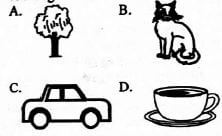
- All the following may be needed for crayon etching except
- a drawing paper.
- a toothpick.
- plasticine.
- black ink.
MUSIC.
- Below is a wind instrument.

The wind instrument above is called- Coro.
- Orutu.
- Kayamba
- Nzumari.
- All wind instruments produce sound when
- shaken.
- hit
- bowed.
- blown
- Body movements or actions used to show the meanings of words or ideas in a song are called
- moods.
- tones.
- dictions.
- gestures.
- Below is a descant recorder.
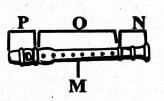
The part labelled N is the- head joint.
- middle joint.
- end joint.
- foot joint.
- The mouth piece is found in part
- M
- N
- P
- O
- The foot joint is labelled
- P
- N
- M
- O
- All the following lines are found in the Kenya National Anthem. Which one is not?
- Kila siku tuwe na shukrani.
- Raha tupate na ustawi.
- Natulinde uhuru na amani.
- Nasi tujitoe kwa nguvu.
- Which of the following types of songs is wrongly matched with its description?
- Topical songs - sung to enlighten the community.
- Action songs - sung during a certain community activity.
- Sacred songs - sung during religious activities.
- Patriotic songs sung to show love for the country.
- Solo singing involves a performance by
- four people.
- three people.
- two people.
- one person.
- Which part of a drum is used to tune it?
- Foot
- Membrane
- Laces
- Resonator
SOCIAL STUDIES.
- All the following are not modern methods of communication except
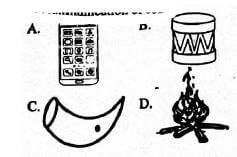
- A motorist approached a road sign like the one shown below

What was the motorist supposed to do?- Turn back
- Call the police
- Turn off headlights
- Slow down
- All the following crops can be grown under horticulture except
- fruits.
- flowers.
- sugarcane.
- vegetables.
- Wildlife is important in our country because it
- rears animals in the country.
- attracts tourists.
- makes learners pass school tests.
- brings visitors to our homes.
- Which of the following fuels can be used in a hurricane lamp?
- Charcoal
- Sawdust
- Firewood
- Paraffin
- All the following are resources found in Kenya except
- museums.
- lakes.
- minerals.
- forests.
- Below is a method of inland fishing in Kenya.

The fishing method shown above is called- long lining.
- purse seining.
- trawling.
- harpooning.
- Study the diagram below

The activity above can be made possible in- forests.
- water bodies.
- mountains.
- valleys.
- All the following are aspects of our traditional culture. Which one is not?
- The foods we eat.
- Our religions.
- The way we build our houses.
- The curriculum we observe in school.
- Traditional artefacts are always kept in
- homes.
- museums.
- markets.
- classrooms.
- Honesty, integrity, trust and respect are examples of school
- core values.
- routine.
- mission.
- motto.
Use the map of Kenya given below to answer questions 32 to 35.
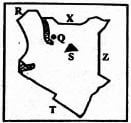
- Which letter represents Ethiopia?
- T
- Z
- X
- R
- The National Park marked Q is called
- Sibiloi.
- Amboseli.
- Maasai Mara.
- Serengeti.
- The country marked R is called
- Uganda
- Sudan
- Ethiopia
- South Sudan
- The mountain marked S is called mount
- Suswa.
- Kenya.
- Marsabit.
- Elgon.
CHRISTIAN RELIGIOUS EDUCATION
- The birth of Jesus was announced by angel
- Micah.
- Gabriel.
- Michael.
- Isaiah.
- The Lord is with you and has greatly blessed you. You will become pregnant and you will give birth to a son. Who was told these words?
- Jesus.
- Joseph
- Mary
- Angel
- Who went around river Jordan mainly preaching to the people about repentance?
- Jesus
- Elisha
- John
- Elijah
- Why is baptism important in the life of a Christian? It
- makes Christians acquire new names.
- makes a Christian a member of God's family.
- makes Christians known by other members of the church.
- is a way of bonding with church elders.
- When Jesus calmed the storm,
- His power over nature was revealed.
- the disciples were in deep sleep.
- His clothes turned crystal white.
- angels appeared to Him.
- Stories that Jesus used to teach people are called
- phrases.
- parables.
- proverbs.
- narrations.
- Why did Zacchaeus climb a sycamore tree?
- He was a sinner.
- He wanted to see Jesus.
- Jesus was passing by.
- The place was overcrowded.
- The second book in the Old Testament is called
- Mark.
- Chronicles.
- Numbers.
- Exodus.
- If your friend insults you, you should
- run away.
- insult him.
- forgive him.
- slap him.
- Which of the following is not a good practice for a Christian?
- Respecting one another.
- Helping the old.
- Abusing others.
- Going to church.
- According to Jesus' teachings during the sermon on the mountain, happy are the pure in heart because
- they will see God.
- God will call them His children.
- God will be merciful to them.
- God will reward them.
- During the baptism of Jesus, all the following took place except
- heaven opened.
- the Holy Spirit came down in form of a dove.
- a voice came from heaven.
- darkness covered the whole place.
- Jesus showed compassion to the needy when He
- performed miracles wherever He went.
- fed a crowd.
- died on the cross.
- promised them the Holy Spirit.
- John the Baptist's mother was called
- Annah.
- Rebecca.
- Elizabeth.
- Mary.
- A person who always tells the truth is said to be
- honest.
- obedient.
- polite.
- kind.
ISLAMIC RELIGIOUS EDUCATION
- How many ayats are there in surah Al- Kauthar?
- 6
- 4
- 3
- 5
- Tarmechim bibijarati minsijjeelin is a supplication from surah
- Fiyl.
- Maun.
- Kafirun.
- Lahab.
- Which of the following is not a lesson from surah Al-Qureish?
- Never take the blessings of Allah for granted
- Allah sends blessings and bounties.
- Allah blessed the Qureish with security.
- Never underestimate Allah.
- Which of the following attributes of Allah means all forgiving?
- Al-Haafidh.
- Al-Ghafar.
- Al-Aalim.
- Al-Malik.
- Which one of the following is not a characteristic of angels? Angels
- can change form.
- were created from nur.
- can either be males or females.
- do not have parents.
- The last swalah of the day is called
- Ast.
- Isha.
- Dhuhr
- Fajr.
- Saum can be described as
- a pillar of religion.
- pilgrimage.
- kindness.
- an act of devotion.
- Hajj is performed in the month of
- Muharram.
- Rajab.
- Dhulhijja.
- Ramadhan.
- The angel of Allah who brings rain is called
- Jibril
- Malik.
- Mikail.
- Israfil
- When you recite dua for leaving and entering the house,
- your faith in religion becomes stronger.
- you become lucky.
- angels surround you.
- Allah protects you.
- Which of the following is not an optional prayer?
- Fajr
- Qabliyah
- Taraweh
- Baadiyah
- Which of the following is not a condition for swalah? One has to
- be in ritual purity.
- wear new clothes.
- be a Muslim.
- have sound mind.
- When we perform swalah correctly, we earn
- points.
- gifts.
- curses.
- thawabs.
- Which of the following is the last step in swalah?
- Maintaining a bowing posture.
- Turning the head to the left.
- Standing straight upright.
- Turning the head to the right.
- As a Muslim child, it is the obligation of my parents to
- obey me.
- cater for my basic needs.
- buy me computer games.
- do my homework for me.
MARKING SCHEME
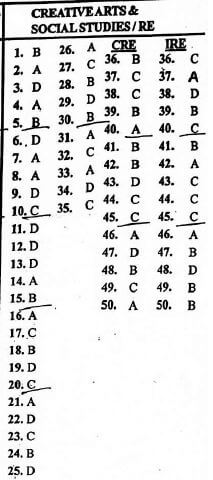
Integrated Science Questions and Answers - Grade 5 Mid Term 2 Exam 2023 Set 1
QUESTIONS
SCIENCE AND TECHNOLOGY.
- Which of the following options consists of non-flowering plants only?
- Sisal, maize, cabbage.
- Algae, pine, moss.
- Liverworts, cactus, maize.
- Blackjack, tea, kale.
- Which of the following is not an importance of flowering plants
- Some flowers are used as medicines.
- Flowers are used for beautification.
- Flowers are used to raise dough in bakery.
- Flowers produce nectar for bees.
- Study the chart below.
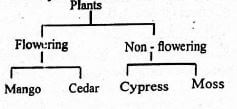
Which plant was wrongly grouped?- Cedar
- Moss
- Mango
- Cypress
- Below is an example of fungi.

Identify it.- Mould
- Penicillium
- Yeast
- Mushroom
- Below are characteristics of a certain group of vertebrates:
- Lays unfertilized eggs.
- Have wet scales.
- Breathe by means of gills.
- Have fins.
Which of the following groups of invertebrates is described above?- Amphibians
- Fish
- Reptiles
- Mammals
- Which one of the following is a sense organ for touch?
- Tongue
- Skin
- Nose
- Eyes
- Study the diagram below.
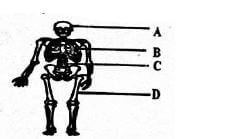
The sternum is labelled- B
- C
- D
- A
- Which of the following parts of the human skeleton is used for protection?
- Limb bone
- Sternum
- Backbone
- Ribcage
- Which of the following parts of a computer is used to process data?
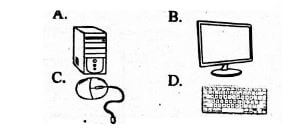
- Wambua was typing an E-mail on his computer. On which part was the text displayed?
- Cables
- VDU
- Speaker
- Printer
The diagram below shows the human breathing system.

- The air we breathe is warmed in the part labelled
- O
- N
- P
- M.
- The part labelled O is called
- bronchus
- air sac
- bronchiole
- diahragm
- Which of the following levers are all in the same class?
- Claw hammer, crowbar, fishing rod.
- Scissors, lid opener, wheelbarrow.
- Spade, broom, fishing rod.
- Lid opener, broom, nutcracker.
- Some learners set up an experiment like the one shown: below
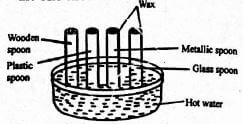
Wax melted on the- wooden spoon.
- plastic spoon.
- metallic spoon.
- glass spoon.
- Which one of the following is not a factor affecting sinking and floating?
- Size
- Shape
- Material
- Weight
AGRICULTURE.
- Soil can be improved by
- adding sand into it.
- adding manures.
- making it wet.
- planting cover crops.
- The illustration below shows an organic waste pit
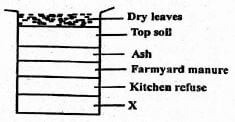
The layer labelled X contains- stones.
- gravel.
- maize stalks.
- soil.
- The following are measures of conserving water in the farm except
- cover cropping.
- mulching.
- shading.
- thinning.
- Small wild animals destructing farming activities cannot be controlled by
- using scarecrows.
- using safe traps.
- poisoning.
- fencing.
- The experiment below can be used to investigate a certain property of soil.
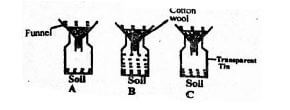
Which property of soil can be investigated using the set up above?- Texture
- Drainage
- Use
- Size of the particles.
- In the farm, water can be used for
- mixing chemicals.
- making fountains.
- transport.
- cooling machines.
- Which small wild animal is correctly matched with the crop it destroys?
- Hare - Coconut.
- Squirrel - Maize seeds.
- Rat - Bananas.
- Monkey - Napier grass.
- Which of the following is the correct use of a scarecrow?
- Killing small wild animals.
- Frightening thieves.
- Frightening small animals.
- Helping farmers to weed.
- Which of the following is not an example of legumes?
- Cowpeas
- Groundnuts
- Greengrams
- Arrowroots
- Which of the following cannot be used to make a container garden?
- Old tyre
- Old polythene bag
- Sack
- Old plastic bucket
HOMESCIENCE
- Below are community members and their ages
Mbula-10 years
Sidi - 6 years
Keziah - 18 years
Kombo - 20 years
Who among them is a pre- teen?- Kombo
- Keziah
- Sidi
- Mbula
- Which of the following changes takes place in girls only during pre- adolescence?
- Broadening of hips.
- Growth of beards.
- Breaking of voice.
- Pimples on the face.
- The type of shoes for a pre- adolescent boy or girl should be
- black.
- big.
- comfortable.
- small.
- Wairimu wants to buy a dress for her birthday party. Which of the following is not an important factor to consider?
- Colour
- Price
- Size
- Manufacturer
- A glass table can be cleaned using
- a soft cloth.
- a broom.
- a brush.
- a rake.
- Which of the following cleaning materials can be used to collect litter?
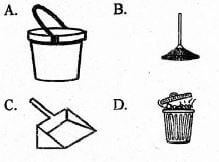
- All the following are common communicable diseases except
- malaria.
- measles.
- ringworms.
- cholera.
- Which of the following is not a media for advertising a product to consumers?
- Market place.
- Television.
- Radio.
- Notice board.
- Which one of the following is not an effect of time wastage?
- Poor performance in school.
- Lack of self esteem.
- Failing to perform.
- Can lead to an unhappy life.
- Below is an example of stitches used on clothes.

The stitch shown above is called- chain stitch.
- back stitch.
- running stitch.
- loop stitch.
PHYSICAL HEALTH EDUCATION.
- Below is an example of starts in athletics.

The type of start shown above is called- bunch start.
- medium start.
- elongated start.
- raise start.
- Relay batons can be improvised using
- stones
- cotton wool.
- sand.
- manila papers.
- Visual baton exchange is a sports activity related to
- relays.
- swimming.
- rounders.
- hurdles.
- The section of the long jump facility that players step on before flight is called
- landing area.
- take off board.
- take off lane.
- runway.
- The rope work technique involving jumping from side to side is called
- straddle cross.
- wounded duck.
- skier.
- single bounce.
- Which of the following is not a type of passes in soccer?
- Tiptoe pass.
- Outside of the foot pass.
- Wall pass.
- Push pass.
- Which one of the following is not a responsibility of an infield player in softball?
- Catching the ball before it hits the ground.
- Backing up outfielders.
- Tagging the running batter using the hand holding the ball.
- Catching buffed fly balls.
- Technical and tactical approaches are applied in
- soccer.
- volleyball.
- rounders.
- swimming.
- Below is a type of serve applied in volleyball

This type of serve is called- underarm serve.
- standing serve.
- overarm serve.
- overhead serve.
- Which one of the following items may not be necessary for improvising a volleyball equipment?
- Old clothes
- Strings
- Sticks
- Rubber bands
- If you get hurt in the process of a game,
- continue playing slowly.
- go to the hospital.
- do not continue playing.
- sit down in the field.
- Which of the following is not a pool activity?
- Standing surface dive.
- Legal touches.
- Front crawl.
- Back stroke.
- Forehand and backhand throws are both applied in
- rounders.
- frisbee.
- soccer.
- volleyball.
- Which of the following activities cannot help in developing muscular strength?
- Hill walking.
- Body weight squat.
- Lifting weights.
- Climbing stairs.
- Which of the following can a player eat two hours before the game?
- Yams
- Eggs
- Fruits
- Honey
MARKING SCHEME

Kiswahili Questions and Answers - Grade 5 Mid Term 2 Exam 2023 Set 1
MASWALI
Soma mazungumzo yafuatayo kisha ujibu maswali 1-5.
Kaka Mbweha: (Akicheka kwa kejeli) Bi Ngiri, mkulima hodari wa mihogo anayeheshimika katika ukanda huu, hujambo?
Bi Ngiri: (Akihema kwa uchovu) Sijambo, lakini nina swali. Unacheka nini? Ama ndio njia yako ya kumfariji anayetoka kuchanika kwenye mpini siku nzima?
Kaka Mbweha: (Anacheka zaidi) Eti kuchanika kwenye mpini? Wachapakazi kama mimi hawana haja ya kujichosha. Wanafanya kazi kwa kutumia akili.
Bi Ngiri: (Kwa dharau) Mhh! Heri nyinyi mabingwa wa kutumia akili. Sisi wengine inabidi tujikaze kisabuni ili tupate riziki.
Kaka Mbweha: (Kwa mshangao) Nyinyi wengine? Wewe na kina nani? Je, huna habari kwamba rafiki zako sungura na fisi hawapandi wala kuvuna lakini daima wana shibe?
Bi Ngiri: (Kwa sauti ya chini) Hayo ya kina sungura hayanihusu ndewe wala sikio. Isitoshe, unavyoona nimechoka. Shamba langu la mihogo liko mbali na kwangu. Bado nina mlima mmoja wa kukwea ndipo nifike.
Kaka Mbweha: Haya basi niazime vipande viwili vya mihogo. Nitarejesha nitakapovuna.
Bi Ngiri: Kaka Mbweha, umesahau kuwa tayari una deni langu la mihogo? Lípa hilo kwanza.
Kaka Mbweha: (Kwa unyenyekevu) Nitalipa tu.
Bi Ngiri: Utanilipa vipi ilhali wewe mwenyewe hukuvuna? Unastahili kufanya kazi kwa bidii. Kumbuka ajizi ni nyumba ya njaa.
- Kulingana na mazungumzo haya, Bi Ngiri anasifika kwa sababu ya nini?
- Kutembea mwendo mrefu kwenda shambani mwake.
- Ukulima wa mihogo.
- Bidii katika shughuli za shambani.
- Kuwashauri wakulima wenzake.
- Chagua sifa inayomfaa zaidi kaka Mbweha kulingana na mazungumzo haya.
- Mchapakazi
- Mnyenyekevu
- Mwerevu
- Mvivu
- Mazungumzo haya yanaweka wazi kuwa anayejitegemea ili kujilisha kikamilifu ni
- fisi.
- sungura.
- kaka Mbweha.
- Bi Ngiri.
- Ni kwa nini Bi Ngiri alimwambia kaka Mbweha kuwa bado alikuwa na mlima mmoja wa kukwea? Ili
- kumjulisha kuwa kulikuwa na milima huko.
- waandamane kuelekea kwake.
- akatize mazungumzo na amruhusu aende akapumzike.
- kumweleza umuhimu wa kuwa na shamba mbali na nyumbani.
- Mazungumzo haya yanatufunza kuhusu
- ubaya wa uzembe.
- umuhimu wa kutumia akili.
- kilimo cha mihogo.
- matumizi ya mashamba.
Soma kifungu kifuatacho kisha ujibu maswali 6 hadi 9.
Ni wajibu wa kila mkenya, awe kijana au mzee, kushiriki katika uhifadhi na ulinzi wa misitu yetu. Kila mmoja ana nafasi yake ya kutekeleza kulingana na umri na uwezo wake. Upanzi wa miti unafaa kuongozwa na vijana kwa sababu wana nguvu ya kutosha. Msimu mzuri wa kupanda miche ni msimu wa mvua nyingi.
Ili kuipanda miti mingi nchini, serikali imetenga siku moja kwa mwaka iwe ya upanzi wa miche, yaani miti michanga. Wengi hivi karibuni wamekosa kuitilia maanani siku hii muhimu. Hapo awali, shughuli hii ilikuwa ikichangamkiwa na kila mmoja katika jamii.
- Kulingana na ufahamu, uhifadhi wa misitu ni wajibu wa
- vijana.
- watu wazima.
- watu wote.
- wanafunzi.
- Je, ni kwa nini vijana ndio wanaofaa kuongoza katika upanzi wa miti?
- Wana nguvu ya kutosha.
- Wanajua kupanda miche zaidi.
- Wao ndio wengi nchini.
- Hiyo ni sheria ya nchi yetu.
- Katika mwaka mzima, siku ngapi zimetengewa upanzi wa miti?
- 3
- 2
- 4
- 1
- Kulingana na ufahamu,
- hata sasa, wanajamii wanachangamkia upanzi wa miche.
- miti michanga sana huitwa miche.
- hapo awali, watu hawakupenda kupanda miche.
- miti ina faida kwa vijana pekee.
Soma kifungu kifuatacho kisha ujibu maswali 10 hadi 12.
Mayowe aliketi kando ya ghala lake tupu. Tumbo lilimnguruma kwa njaa. Aliishi hivyo kwa siku tatu. Mtama aliokuwa ameuweka katika ghala uliibwa na manyani na tumbili waliotoka katika msitu wa Marura. Mahindi nayo yaliyokuwa tele humo ghalani yaliliwa yote na kuchakulo. Kando yake kulikuwa na kibuyu. Kibuyu hicho kilisoma akili yake haraka na kumwambia kwa sauti, "Fanya chaguo!" Mayowe alisema kwa sauti, "Ninataka chakula!" Ghafla bin vuu, ghala likajaa mihogo na viazi. Mayowe alifurahi kuliko siku zote za maisha yake.
- Mwanzoni mwa ufahamu, ghala la Mayowe lilikuwa na nini?
- Mihogo na viazi.
- Lilikuwa tupu.
- Mahindi na mtama.
- Mtama na viazi.
- Tumeambiwa kuwa Mayowe alihisi njaa kwa muda wa
- wiki tatu.
- miaka mitatu.
- saa tatu
- siku tatu.
- Manyani na tumbili wezi walitoka wapi?
- Katika kijiji jirani.
- Mlimani.
- Mtoni Marura.
- Msituni Marura.
Soma kifungu kifuatacho kisha ujibu maswali 13 hadi 15.
Kuna umuhimu mkuu wa kudumisha afya bora. Binadamu akiwa na afya bora huweza kufanya shughuli zote vizuri na kwa wakati unaofaa. Ili kuwa na afya bora, ni vizuri kuzingatia lishe bora. Chakula tunachokila lazima kiwe na kabohaidreti, protini na vitamini kwa viwango vinavyofaa mwilini. Vilevile, ni vizuri kunywa maji safi na salama kila siku. Je, wajua kuwa matunda hutukinga tusiwe wagonjwa? Wapishi na watu wote wanaoandaa chakula ni lazima wawe safi ili tusipatwe na magonjwa.
- Taarifa hii inasema kuwa inatulazimu kudumisha
- lishe bora.
- chakula bora.
- afya bora.
- usafi wa hali ya juu.
- Tumean.biwa kuwa chakula chetu ni vyema kiwe na
- kabohaidreti na protini.
- vitamini na kabohaidreti.
- kabohaidreti na protini.
- vitamini, kabohaidreti na protini.
- Kulingana na taarifa hii, matunda
- hutuletea magonjwa.
- hutukinga dhidi ya magonjwa.
- huwa na ladha ya kuvutia.
- yanafaa kuwa safi na salama.
Soma kifungu kifuatacho. Chagua libu lifealo zaidi kati ya yale uliyopewa
Wapo wanyama mbalimbali ...................16................. katika mbuga zetu. Kuna wale ambao huwawinda wenzao kama vile simba, chui na ...................17.................. Hawa huwa ...................18................. mchana wote. ...................19.................kuwaona, lazima ufike mbugani mapema kabla ya ...................20.................kuchomoza.
-
- zilizo
- iliyo
- aliye
- walio
-
- farasi
- ngamia
- duma
- ndovu
-
- hawalali
- hawaamki
- wamelala
- wanalala
-
- Hili
- Ili
- Hii
- Kwa sababu
-
- giza
- mwezi
- nyota
- jua
Katika swall la 21-30, libu swall kulingana na maagizo uliyopewa.
- Chagua kundi la nominoambata pekee.
- Umati, kicha, mlolongo.
- Mjombakaka, mjusikafiri, mlariba.
- Huzuni, furaha, hasira.
- Meza, kalamu, darasa.
- Chagua nomino iliyo tofauti na nyingine.
- Alhamisi.
- Upendo.
- Agosti.
- Jumanne.
- Chagua sentensi iliyoakifishwa ipasavyo.
- Alisema kuwa amemaliza kazi.
- Kwani mzazi wako hajafika.
- Wanafunzi wenzangu ni Timami, Maimuna na Recho.
- Naam, nimekuelewa sasa.
- Je, ni pambo gani hapa linaloweza kuvaliwa masikioni?
- Bangili.
- Kipuli.
- Ushanga.
- Hina.
- Chagua nomino zilizo katika ngeli ya I-ZI.
- Gari, tunda, tausi
- Uzi, ushanga, ukuta.
- Kinyonga, kiwavi, kinda.
- Pua, shingo, karatasi.
- Umepewa maneno manne hapo. Chagua litakalokuwa la kwanza katika kamusi.
- Kofia
- Konsonanti
- Koleo
- Kondakta
- Mwenzako akikuambia alamsiki utamwambiaje?
- Nawe pia
- Binuru
- Jaala
- Inshallah
- Kanusha sentensi ifuatayo: Nilimwona akiingia.
- Nilimwona akiondoka.
- Sikumwona akiondoka.
- Sikumwona akiingia.
- Nilimwona akija.
- Ukubwa wa nomino mti ni
- miti.
- jiti.
- kijiti.
- vijiti.
- Kamilisha tashbihi ifuatayo:
Mzee Mapunda ni mkali kama- wembe.
- shubiri.
- pilipili.
- simba.
MWONGOZO

English Questions and Answers - Grade 5 Mid Term 2 Exam 2023 Set 1
QUESTIONS
Read the following conversation and then answer questions 1 to 5.
Tina : Good morning Tonny, how was your weekend?
Tony: Morning Tina. I have to thank God that my weekend was one of the best I have ever known since we joined this class.
Tina: Sounds quite amazing. Why was the previous weekend the best to you?
Tony: My family and I went to Marura National Park and...
Tina: The one in Wanyama scenery?
Tony: Yes, that one. I saw different types of animals I tell you!
Tina: Wow! Did you see the giraffe? Someone told me that it is the animal with the longest neck.
Tony: Yes, that is true. We also saw elephants, hyenas, lions and ostriches, the biggest and fastest birds in the world.
Tina: I love to hear that. I would also like to visit Marura National Park.
Tony: Oh really? Why don't you accompany me during August holiday when I shall be visiting Pori Game Reserve?
Tina: Thank you Tony. You are indeed a true friend.
Tony: You are welcome Tina.
- Which of the following animals has not been mentioned in the conversation?
- Giraffe
- Hyena
- Lion
- Leopard
- Likely, Tony visited the park with his
- mother, father and sisters.
- friends and relatives.
- brother and classmates.
- family and Tina
- What from the conversation shows that Tina was eager and impatient?
- She confirmed that the giraffe has the longest neck.
- She visited Pori for the first time.
- She interrupted Tony's explanation.
- Tony invited her to join him on a trip to Pori.
- The weekend was good for Tony because
- he saw a giraffe.
- they visited a National Park.
- Tina had accompanied him to Wanyama scenery.
- he saw the biggest and fastest birds.
- Towards the end of the conversation, Tina was happy because
- she had visited a National Park.
- Tony was a good friend.
- she would accompany Tony to Pori.
- she had visited Pori Game Reserve.
Read the passage and then answer questions 6 to 9.
"Aah, I am the fastest among you all" Hare told the animals in a meeting. It was true that hare was faster than most animals but not all, but he was full of pride. All the animals had been invited by their king, lion, to discuss some issues that concerned them. In the past competition, hare had beaten his long time rival, leopard, by far. So, many animals knew that hare was a hero in marathon races and ?" Hare asked jumping on the platform after the meeting had ended. "Hare is the hero!" Many of his spectators answered in unison. King lion looked at the hare and smiled. Hare was a small animal but he had become famous in the whole animal kingdom.
- How many animals have been mentioned in the story?
- Four
- Two
- Three
- Many
- We are told that hare was faster than most animals but not all. This means that
- there were some animals faster than hare.
- hare was the fastest animal.
- most animals were faster than hare.
- all animals were faster than hare.
- Why do you think hare was jumping on the platform?
- He had beaten all the animals in the race.
- He was dancing for the other animals
- No animal dared to compete with him.
- He was responding to the king's order.
- Why did the lion smile after looking at the hare? He
- was the hero in marathon races.
- had been declared the king.
- thought hare was the most couragious animal.
- was a small animal but had become famous.
Read the passage and then answer questions 10 to 12.
There are many uses of old items that most of us think should be thrown away. Using old items for the second time or third time is called re-using. Re-using is the best way to reduce waste. With the current competency based curriculum, some learning areas are guided to carry out different projects. Some of these projects may end up needing some of these old items. For example, there is a quick and easy project that can be done with a can. You need an old can, scissors, glue and coloured papers. First, ask an adult to help you remove the top of the can with a can opener. Wash and dry the can, draw the shapes on the coloured paper with a pencil. Use the pair of scissors to cut the papers into different shapes. Decorate the can with the pieces of papers using glue. Add other materials like pieces of clothes. The old can is now a vase flower holder!
- According to this passage, old items should be
- thrown away
- made into flower holders.
- re-used.
- used for academic projects.
- What is the real meaning of re-using as per the writer?
- The act of using something.
- Using something for the second or third time.
- Using something continuously.
- Avoiding to use something at all.
- Generally, this passage passes an important lesson on
- creativity.
- classroom activities.
- competency based curriculum.
- uses of old cans.
Read the passage and then answer questions 13 to 15.
The long awaited day was finally around the corner. I hardly slept that night. I kept on thinking about the following day. We were to have an academic school trip to Kombora National Park. Those who had paid for the trip were very lucky. They would see many animals like zebras, elephants, gazelles, buffaloes and giraffes among others. My parents had made the payment and I would accompany the other pupils.
We were to travel by bus. The bus arrived very early in the morning. The class teacher read the list as we boarded the bus. I selected a seat next to the window where I would enjoy looking outside as we travelled.
- The second sentence means that the writer
- slept very hard.
- did not sleep at all.
- did not sleep well.
- stayed awake the whole night.
- According to the passage, who were lucky?
- Those who had planned to pay for the trip.
- The pupils who did not pay for the trip.
- All the pupils in the writer's class.
- Those who had paid for the trip.
- Which of the following animals has not been mentioned in the passage?
- Lions
- Gazelles
- Zebras
- Elephants
Read the passage below. It contains blank spaces numbered 16 to 20.
For each blank space, select the best alternative from the choices given.
When I arrived in the ..................16.................. of the accident, I was..................17.................. beyond words. Broken glasses were scattered all over and the luggage was strewn by the sides of the road. It was as clear as..................18..................that a van had a head on..................19..................with a lorry. In fact, it was the speeding van that had slammed into a lorry that was heading to the..................20..................
-
- seen
- sport
- scene
- sin
-
- chocked
- shocked
- choked
- shock
-
- crystal
- polythene
- sound
- daybreak
-
- coalition
- collision
- collusion
- collection
-
- same
- above
- forward
- opposite
For questions 21 to 23. select the best interrogative to complete the sentences.
- ......................................won the match?
- Where
- Which
- Who
- What
- ......................................was the competition held?
- Which
- Whose
- What
- Where
- ......................................did you learn yesterday?
- Who
- Whom
- What
- Whose
In questions 24 to 27. Choose the correct order of adjectives to fill in the blank spaces.
- My mother's room has a......................................carpet.
- big circular old
- big old circular
- old big circular
- old circular big
- Our head teacher wears a......................................jacket.
- baggy big old
- big old baggy
- baggy old big
- big baggy old
- There is a......................................fort near Wanyama animal orphanage.
- huge tall ancient
- tall ancient huge
- huge ancient tall
- tall huge ancient
- I saw a......................................table in the senior teacher's office.
- small new oval
- new oval small
- small oval new
- new small oval
For questions 28 to 30, select the best alternative to fill in the blank spaces.
- Kauleni and I......................................visit the children's home next week.
- will
- shall
- are
- could
- The teacher......................................take us to the field.
- shall
- are
- is
- will
- Mutinda and his younger sister......................................bring us new toys.
- shall not
- have
- will
- are
MARKING SCHEME

Mathematics Questions and Answers - Grade 5 Mid Term 2 Exam 2023 Set 1
QUESTIONS
- Mayowe town had a population of nine hundred and ninety eight thousand, six hundred and forty five people. How many people are these in symbols?
- 998 654
- 988 645
- 998 645
- 989 654
- What is the total value of digit 8 in the number 64 810?
- 8000
- 80
- 80 000
- 800
- A tailor had a piece of cloth material of a certain length. If she cut it in equal pieces measuring 18 cm and 24 cm, what is the shortest length of the material she had?
- 42 cm
- 180 cm
- 72 cm
- 56 cm
- A teacher wrote 45 and 60 on the chalkboard. He told the learners to discuss in pairs and calculate the GCD of the two numbers. What was the correct answer?
- 15
- 5
- 105
- 45
- During a fundraising ceremony, there were 9 675 people. Out of these, 4 353 were females and the rest were males. How many males were there.
- 5 321
- 5 222
- 5232
- 5 322
- In a certain constituency, there were 26 204 women, 22 102 men and 40 222 youths who registered as voters. How many registered voters were there altogether?
- 48 306
- 88 528
- 110 630
- 62 324
- In a school fundraising ceremony, parents contributed 6/11 of the money and the guest of honour contributed 4/11. What fraction of the money was contributed by both the parents and the guest of honour?
- 10/11
- 1/11
- 10/22
- 21/5
- Learners weighed two cocks in their school and recorded their mass as follows:
1st cock - 4.001 kg.
2nd cock - 3.875kg.
What was the total mass of the two cocks?- 0.126 kg
- 7.776 kg
- 8.876 kg
- 7.876 kg
- A doctor had 156 medicine tablets. He gave the medicine equally among 13 patients. How many tablets did each patient get?
- 12
- 11
- 13
- 14
- In a school hall, there are 246 benches. Each bench is used by 12 learners comfortably. How many leamers can sit on all benches?
- 2852
- 2952
- 2942
- 2592
- Manywele cycled from his home to school, a distance of 2 km 400 m, while Mwema cycled from his home to school, a distance of 1 km 800 m. What distance did Manywele cycle than Mwema?
- 1km 600 m
- 4 km 200 m
- 600 km
- 600 m
- The diagram below represents Auma's square table top

What is its area?- 72 cm2
- 36 cm2
- 324 cm2
- 334 cm2
- In a birthday party, juice was stored in 8 containers. Each container had 6 litres 200 ml. How much juice was stored?
- 481 L 1 600 ml
- 48 L 600 ml
- 49 L 1 600 ml
- 49 L 600 ml
- Calculate the area of the figure drawn below

- 342 cm2
- 242 cm2
- 74 cm2
- 332 cm2
- A cartoon program lasted for 30 minutes while a news program lasted for 45 minutes. How long did the two programs take altogether?
- 75 seconds
- 4 500 minutes
- 4 500 seconds
- 750 minutes
- Rashid started reading from 2.30 pm to the time shown in the clock face below.
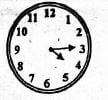
For how long did he read?- 1 hour 45 minutes
- 1 hour 30 minutes
- 2 hours 45 minutes
- 2 hours 30 minutes
- Mwende weighs 25 kg 800 g while her younger brother weighs 5 kg 200 g lighter than her. What is her younger brother's mass?
- 31 kg
- 20 kg 600 g
- 20 kg 1600g
- 21 kg 600g
- Work out
Hours Minutes
29 47
- 16 39
- 45 hours 86 minutes
- 45 hours 8 minutes
- 13 hours 86 minutes
- 13 hours 8 minutes
- During an Art and Craft lesson, a teacher wanted learners to do 3 activities within the remaining 27 minutes 6 seconds. If each activity was to take equal time, how long would this be?
- 81 minutes 18 seconds
- 8 minutes 2 seconds
- 9 minutes 2 seconds
- 9 minutes 12 seconds
- The total mass of the three children is 97 kg. Two of them weigh 29 kg and 23 kg respectively. What is the mass of the third child?
- 52 kg
- 149 kg
- 45 kg
- 145 kg
- Which of the following does not display a correct line of symmetry?
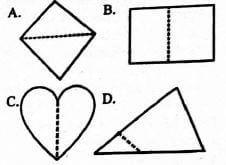
- A learner drew a shape with the following characteristics:
- It had four angles.
- The figure had four sides.
- All the angles were right angles.
- Not all sides were equal.
The shape the learner drew was likely to be- a triangle
- an oval
- a square
- a rectangle
- Study the illustration below.

The illustration above shows a- half turn.
- full turn.
- anti-clockwise turn.
- a quarter turn.
- Mumbi had p seeds for an Agricultural activity. If she gave 14 seeds to her friend, which of the following expressions shows the number of seeds she remained with?
- 14+p
- p x 14
- p-14
- 14+p
- Mwachofi had 3 oranges. He bought more oranges. In total, he had 10 ranges. How many oranges did he buy?
- 7
- 13
- 5
- 4
- Samantha carried 24 pebbles to school. On her way, x pebbles got lost. She was left with 19 pebbles. How many pebbles got lost?
- 5
- 43
- 7
- 6
The table below shows the number of animals in Kant's farm
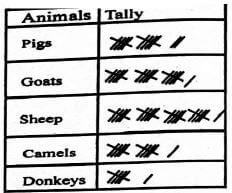
- Which animals were the least?
- Goats
- Donkeys
- Pigs
- Sheep
- How many more sheep were there than donkeys?
- 30
- 25
- 15
- 31
- What was the total number of pigs and goats?
- 28
- 39
- 29
- 19
- How many animals are in Kambi's farm altogether?
- 71
- 70
- 56
- 66
MARKING SCHEME

Creative Arts, Social Studies & Religion Questions and Answers - Grade 5 Opener Exams Term 2 2023 Set 1
QUESTIONS
SECTION 1:ART AND CRAFT.
- Which one of the following is not an element of art?
- Line
- Texture
- Shape
- Form
- An artist can create a realistic still life composition with the following features except
- movement
- balance
- proportion
- overlapping
- The following are materials used in still life drawing. Which is the odd one out?
- Drawing surface
- Pencil, charcoal, crayon or chalk
- Ruler
- Paint brush
- The following are examples of dry media required in the smudge technique. Which one is the odd one out?
- Charcoal
- Pencil
- Chalk
- Paint
- Which one of the following is not a way one can use to create value gradation effect when smudging with dry media?
- Spreading the applied media using a finger
- Using a blunt object to scratch off colour
- Smearing the surface with colour using a soft cloth
- Varying the intensity of shading in a picture
Use the picture below to answer questions 6 and 7.
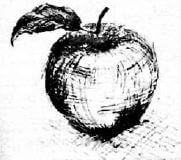
- Which drawing technique has been used in drawing the above cylindrical form?
- Shading
- Crayon etching
- Smudging
- Cross hatching
- What is the effect of using lines that are close to one another in the drawing?
- Creates a dark effect
- Creates a light effect
- Shows overlapping areas
- Shows the source of light
- The following are materials required in making wax crayons except.
- bees wax
- paraffin wax
- pigment
- water colours
- Why is soap used when applying the dark coat over the crayon rubbing?
- To clean the surface to be covered
- To make the surface slippery when working
- To help the ink or paint stick on the crayons
- To avoid melting of the wax crayons
- Primary colours are ................. , ................. and ....................
- black, white and grey
- red, blue and yellow
- violet, green and orange
- green, blue and violet
- What is the resultant colour when two primary colours are mixed?
- Mixed primary colour
- Secondary colour
- Tertiary colour
- Complementary colour
- The following are locally available adhesives one can use to stick cut-out pictures and photographs when making a montage.
Which one is not?- Mauritius thorn seed pod
- Hooves and horns
- Euphorbia tree sap
- Office glue
- Which of the following is not a way of preparing stiff fibres from plants in readiness for weaving?
- Soaking
- Splitting
- Stripping
- Twinning
- Which one of the following is not required when improvising a leather pencil case?
- Cutting tools such as skiving knives, blades and scissors
- Leather punch
- Sharp tipped hard wire or nail
- A hollow cylindrical container
- Making pots as shown in the following picture is by the
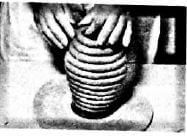
- coil technique
- slab technique
- pinch technique
- wheel throwing technique
SECTION 2: MUSIC
- SAT are voices sung by.
- Two tenors and an alto line.
- Soprano and alto line.
- Two soprano and two alto lines.
- Soprano, tenor and alto
- Which letters fill the spaces below!
dr........f........- f.r
- la, ti
- m, s
- r.d
- How many people cannot take part into a two-part song?
- 3
- 1
- 5
- 7
- Why do participants in an African performance adorn their bodies?
- To identify with all communities.
- To maintain the beat.
- To help keep their part.
- To look colourful for the audience
- AB structure is called?
- Binary or in two sections.
- Ternary or in three sections.
- Quintet or in five sections.
- Quartet or in four sections.
- ta-te has.............beat count.
- 1
- 1/2
- 2
- 3
- Which one of the following is not a difference between percussion instruments and wind instruments?
- Method of playing
- Method of tuning
- Method of maintenance
- Materials for making the instrument
- Issues affecting our society are called
- Major issues
- Politics
- Moral issues
- Pertinent Issues
- Which one of the following is not a technique of playing a descant recorder?
- Striking the strings
- Tonguing the mouth piece
- Fingering
- Gently blowing air into the mouth piece
- Which holes are covered when playing note lower C on a descant recorder?
- All
- 1, 2, 3, 5
- 2.4.6.7
- 1.7
SECTION 3: SOCIAL STUDIES
Study the map below and answer the questions 1 to 5.
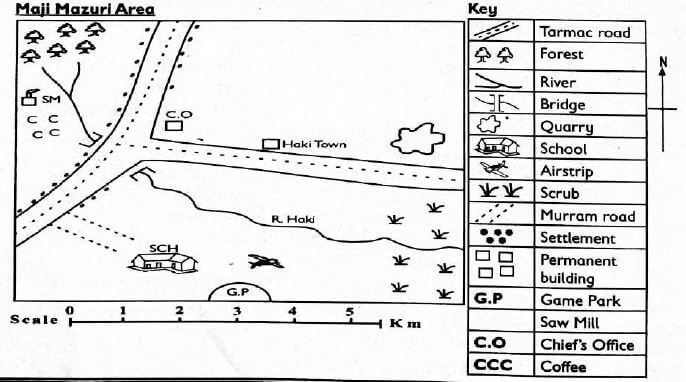
- What is the population pattern in Maji Mazuri Area?
- Dense
- Clustered
- Linear
- Nucleated
- Which of the following is not an economic activity practised in Maji Mazuri Area?
- Tourism
- Pastoralism
- Mining
- Farming
- What is the climatic condition in the east of Maji Mazuri Area!
- Cool and wet
- Hot and dry
- Dry and wet
- Cool and dry
- What is the direction of scrub vegetation from the forest?
- South
- North
- North East
- South West
- Limestone is mined at Maji Mazuri Area.
What means of transport is used to transport it?- Railway
- Air
- Road
- Water
- A map has.........................key elements.
- 4
- 7
- 5
- 9
- Barry listed the following as cash crops.
Which one is not correct?- Tea
- Pyrethrum
- Sukuma wiki
- Coffee
- Kenya borders Tanzania to the
- South
- West
- North
- East
- Name the relief feature shown on the map below.
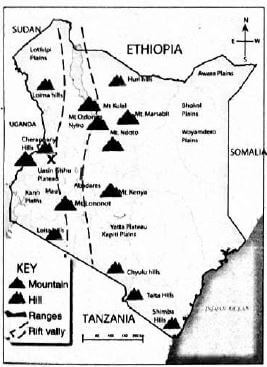
- Mt Kilimanjaro
- Mt Elgon
- Mt Kenya
- Mt Marsabit
- Which of the following weather elements is not correctly named?
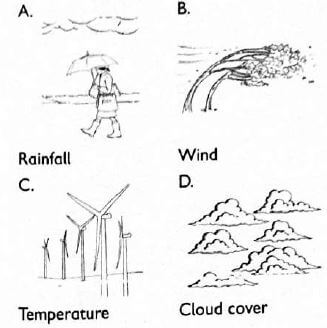
- The climate of a region is mainly influenced by altitude. Which climatic region is described?
- Tropical climate
- Desert
- Mountain equatorial
- Modified
- Which of the following is a monument?
- Tom Mboya
- Fort Jesus
- Gedi Ruins
- Koobi Fora
- Museums preserve our ................... and traditions in our country
- Culture
- Food
- Homes
- Elders
- Makena categorised communities according to their language groups as follows. Which one is correctly matched?
- Bantu- Iteso, Elmolo
- Cushites- Luo, Terik
- Nilotes- Pokot, Keiyo
- Asians- France, Italy
- The following areas are densely populated except.
- Coastal areas
- North of Lake Victoria
- Highlands
- Deserts
SECTION 4: CHRISTIAN RELIGIOUS EDUCATION.
- God created the whole world and rested on the ................................ day
- First
- Third
- Fifth
- Seventh
- Why did Eve agree to eat the forbidden fruit!
- She wanted to be wise like God
- She wanted to be foolish
- She did not know it was forbidden
- She was not hungry
- Which punishment was given to Eve after they ate the forbidden fruit?
- She was told never to eat fruits
- She would feel pain when giving birth
- She was told to eat dust
- She would have to wear leaves
- Sierra was feeling confused about how to differentiate a talent and an ability She spoke to the following people to get advice on how to use her talents. Which one of them had the best advice?
- Her small sister
- Her father
- Her classmate
- A stranger
- From the story of the rescue of baby Moses by Pharaoh's daughter we can learn the following values except?
- Unkindness
- Love
- Compassion
- Empathy
- Which of these children show good stewardship in school?
- Velma- Loses her text books and her uniform items frequently
- Brianna-Tears pages from her exercise books and throws them around the classroom
- Drake- Breaks school desks and chairs
- Didi- Switches off the lights and takes care of her property
- Jacky's friends are always gossiping about the others. She does not like it. Which of these reasons could make Jacky still stay with those friends!
- Loneliness
- Good role models
- Having little time
- Honouring God
- Which of these values can we use to nurture. our talents and abilities?
- Laziness
- Fear
- Honesty
- Irresponsibility
- Which of these children has been denied their rights?
- Annete-Arranging the books on the shelf
- Brenda - Helping with chores around the house
- Imelda- She works in a coffee plantation
- Charles-He can play together with his friends.
- Which sin did the first human beings commit?
- Adultery
- Disobedience
- Murder
- Stealing
SECTION 4: ISLAMIC RELIGIOUS EDUCATION.
- Which surah tells us that AbraAshram wanted to destroy Kaaba
- Fiyl
- Humaza
- Falaq
- fatiha
- Which surah warns backbiters, rumour mongers and misers
- Maun
- Humaza
- Lahab
- nas
- Which surah is a must in every swalab
- Falaq
- Nas
- Ikhlas
- Fatiha
- Surah Ikhlas tells us that
- We should pray
- To obey our parent
- We should be patient
- Allah is one
- The holy prophet (SAW) said "A ................... is a brother to another Muslim
- Muslim
- Muumin
- Neighbour
- Swalah is the pillar of
- Religion
- Islam
- Iman
- Zakot
- The holy prophet (SAW) said "Tell the truth even though is,
- Now
- Tomorrow
- Sweet
- Bitter
- Najis is divided into class
- 2
- 3
- 5
- 6
- ...............................is the third pillar of Islam
- Swalah
- Saum
- Zakat
- Hajj
- Before offering our swallah we should do,
- Udhu
- Tayamum
- Salaams
- Dua
MARKING SCHEME

Integrated Science Questions and Answers - Grade 5 Opener Exams Term 2 2023 Set 1
QUESTIONS
SCIENCE AND TECHNOLOGY
Grade 5 learners wrote the following characteristics of a vertebrate. Use the characteristics to answer question 1 and 2.
- They are warm blooded.
- They have a hairy body.
- They give birth.
- They feed the young ones through mammary glands.
- The characteristics refer to
- amphibians
- mammals
- reptiles
- birds
- The characteristics apply to all the following animals, except;
- duck billed platypus
- whale
- bat
- a human being
- Which of the following statements is true about the animal shown below?

- It is warm blooded.
- It breathes through lungs.
- Its body is covered with a moist skin.
- It gives birth to young ones.
- Which one of the following is an example of small fungi?
- yeast
- mushroom
- puffballs
- toadstools
- What is the function of the rectum in digestion?
- to absorb digested food into the body
- to temporarily store feces before egestion
- to absorb water back into the body
- to produce digestive juices
- Njuguna was using a spade as shown below.

Identify the FULCRUM from the diagram.- Z
- X
- Y
- Q
- Which one of the following plants produces through cones?
- pine
- fir
- cypress
- cedar
- Zawadi and Nuru were balancing on the see saw as shown below.
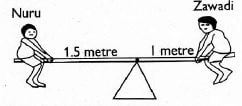
From the set up, it is true that;- Zawadi and Nuru have equal mass.
- Zawadi is heavier than Nuru.
- Nuru is heavier than Zawadi.
- Zawadi is older than Nuru.
- .......................................is the process through which green plants make their own food.
- hydrolysis
- photolysis
- photosynthesis
- respiration
- The part of the eye that controls the amount of light passing into the eye is known as.
- iris
- eyelids
- pupil
- eye lashes
- Which of the following activities can be carried out by a grade one boy during windy weather?
- burning rubbish
- flying kites
- winnowing
- drying clothes
- When modeling the respiratory system, the balloons represent
- thorax
- diaphragm
- lung:
- windpipe
- Which of the following statements is true?
- Filtered water is safe for drinking.
- Light moves in all directions.
- Force can change the shape of an object.
- Size affects floating and sinking.
- Air pollution on dusty grounds can be controlled by all the following except;
- sprinkling water on the ground
- planting grass on the ground
- planting trees near the area
- disposing litter at the right place
- The part of the computer that processes data is called
- CPU
- monitor
- mouse
- keyboard
AGRICULTURE
- Grade 4 learners from Jikazeni Junior School were asked to name practices that conserve water in the soil. Who gave two correct answers?
- Marko: irrigating and shading
- Yohana: shading and mulching
- Luka: mulching and pruning
- Mathayo: thinning and weeding
- It is true that the soil with the smallest particles;
- retains no water.
- retains the smallest amount of water.
- retains medium amount of water.
- retains the highest amount of water.
- Which of the following statements is true about drip irrigation?
- It can only be done using bottles.
- It can only take place in the evening.
- It is a method that conserves water.
- It can only be done using perforated bottles,
- To ensure that nutrients are not washed away, it is advisable that;
- compost materials should be heaped under a tree.
- compost materials should be frequently turned.
- water should be sprinkled on the compost materials.
- ash should be sprinkled on the compost materials.
- Usually, the soil that is eroded is
- dry soil
- loose soil
- compact soil
- fertile soil
- For the seedlings to be ready for strong, direct sunlight after transplanting, it is advisable to;
- reduce the number of thinning on the nursery
- reduce the mulches.
- reduce the number of times of watering in a day
- reduce the shading on the nursery.
- Which one of the following crops cannot grow well in clay soil?
- potatoes
- cabbages
- rice
- groundnuts
- Which one of the following is the damage caused to crops by squirrels?
- They eat young chicks.
- They eat the roots of crops.
- They feed on small domestic animals.
- They eat the grains of maize."
- Which of the following practices ensures that a few number of healthy seedlings remain in the nursery bed?
- mulching
- shading
- weeding
- thinning
- Grade 4 learners from Miachake Academy sold some of the seedlings from the nursery bed at school. What would you advise them to do with the money they got from the sale of the seedlings?
- buy farming tools to be used on the school farm
- share the money among all the class members
- give the money to one of the classmates to keep
- buy some sodas in the nearby kiosk and take
- Which one of the following is a legume?
- sorghum
- peas
- rice
- millet
- What is the importance of recovering eroded soil and taking it back to the farm?
- to restore soil fertility
- to conserve soil moisture
- to kill weeds
- to reduce soil erosion
- Growing crops that spread on the ground is known as:
- mono-cropping.
- intercropping.
- cover cropping.
- ground cropping.
- Mkulima trapped a monkey that was destroying crop on his farm. What would you advise him to do?
- kill the monkey
- gently release the monkey
- keep the monkey at home
- give the monkey to his dogs
- Which of the following is not an importance of wild animals to the community?
- They eat other harmful animals.
- They attract tourists.
- Watching them brings relaxation.
- People get jobs when caring for the animals.
PHYSICAL HEALTH EDUCATION
- .....................................are the serial of barriers that bring obstacles while running.
- hurdles
- batons
- discus
- starter
- The normal heart beat of an adult is, beats per minute.
- 50-80
- 40-60
- 60-100
- 70-90
- Performing different skills together is known as
- combining
- resilience
- momentum
- fair play
- Identify the skill being performed by Fanaka in the picture below.
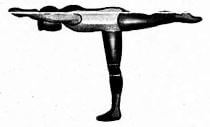
- handstand
- T-balance
- roll-balance
- headstand balance
- What is the importance of having an adult who knows how to swim with you during swimming?
- To save you in case you drown.
- To ensure that the swimming pool is clean.
- To ensure there is lifesaver around.
- To ensure that the swimming pool is safe.
- Teacher Omusikoyo carried the item shown below during a Physical and Health Education lesson. Which game do you think he wanted the learners to play?

- Softball
- Rounders
- Frisbee
- High jump
- The following are the importance of warm up activities. Which one is not?
- They prepare the body for the game of day
- They help to prevent injury
- They prepare the brain for the activities.
- They make the heartbeat to go back to normal.
- Grade 5 learners were asked to identify the skill shown below. What is the correct answer?
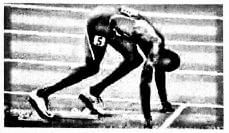
- medium start
- elongated start
- standing start
- bunch start
- Which of the following shows the correct progression of a standing discuss throw?
- grip, swing, release, recovery, stance
- stance, grip, release, recovery, swing,
- release, recovery, stance, grip, swing
- stance, grip, swing, release, recovery
- During visual baton exchange;
- the receiver of the baton does not see it as he or she receives.
- the receiver of the baton must see it as he or she receives.
- the giver of the baton does not see it as he or she gives put.
- the baton is thrown to the receiver.
HOME SCIENCE
- Why should a thermo-flask be kept away from children?
- it is poisonous
- it is expensive
- it can easily break
- it is big
- At what age can one be referred to as a pre-teen?
- between 9 and 12 years
- between 9 and 15 years
- between 7 and 9 years
- between 13 and 19 years
- Identify an effect of wasting time from the answers below.
- satisfaction
- poor performance
- high self esteem
- good relationship
- Which of the following is not a factor to consider when choosing shoes?
- weather
- occasion
- comfort
- nationality
- Time plan is important because it helps to avoid;
- impulse buying.
- organization.
- time wastage.
- controlled use of social media.
- Which of the following is the best way to spend leisure time?
- sleeping
- watching television
- listening to music
- visiting the sick
- Utensils that break easily are called;
- disposable utensils.
- fragile utensils.
- durable utensils.
- expensive utensils.
- Why is it necessary to boil milk before taking?
- to last longer
- to kill germs
- to make it tasty
- for easier digestion
- Which of the following fuels should be used with open doors and windows?
- firewood
- paraffin
- gas
- electricity
- Mzee Ojwang had the following on his shopping list.
- smart phone
- food
- a bicycle
- clothes
Which of the items should he consider first?- ii
- iii
- i
- iv
MARKING SCHEME



